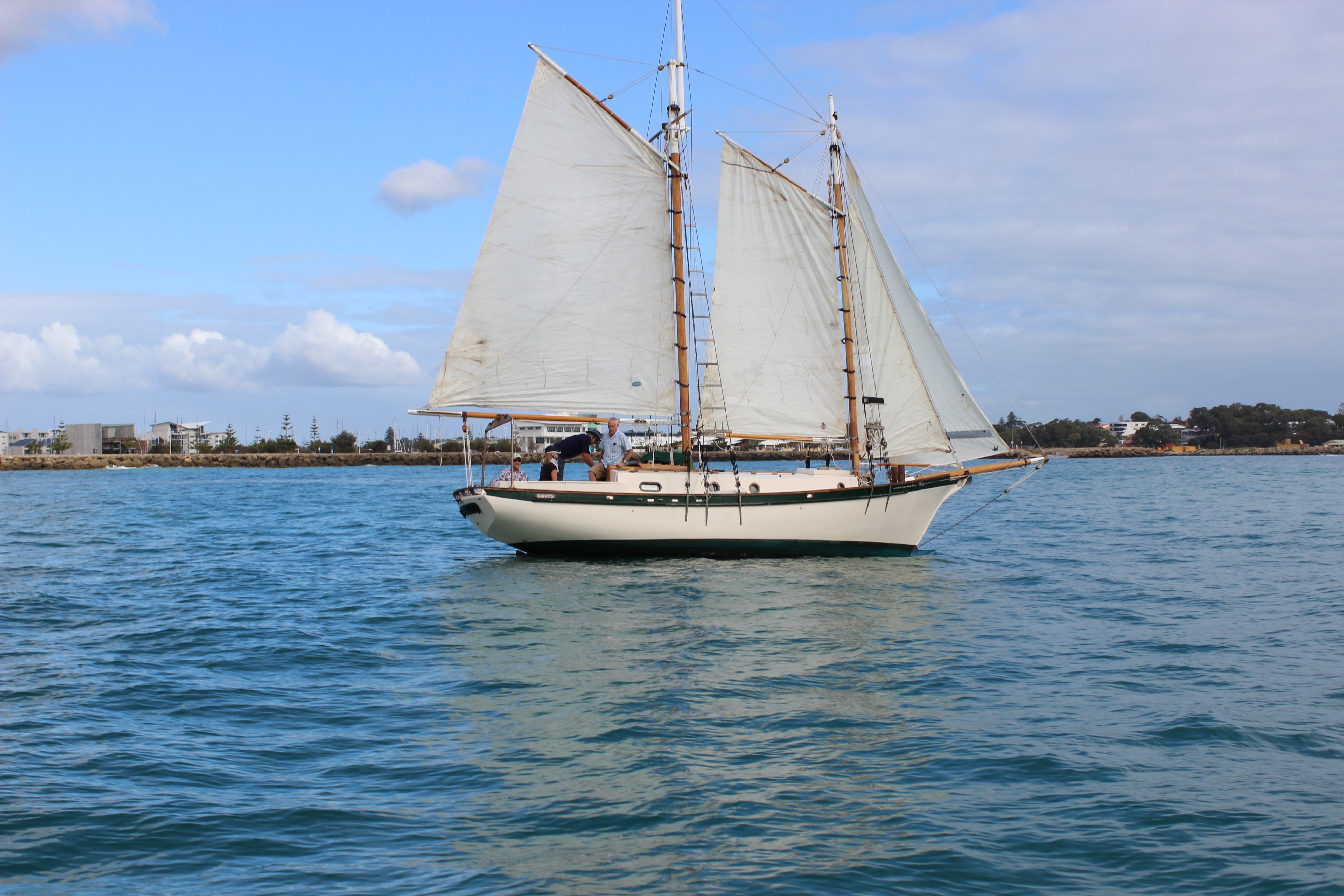The following week’s sea trail took place on a sunny and still winter’s day. Our ‘salt of the sea’ friend came along to help out and appraise Ashanti’s performance. Satisfied the motor proved powerful enough to drive us through the fast channel current beyond the marina walls, we hoisted the sails and she sailed gently in the light airs. Her leather lined throat creaked and groaned against the mast, a comfortable old world sound bringing to mind the romance of a pirate ship. Literally there to ‘learn the ropes’ we mined Colin for every bit of information we thought we might need to know. Obliging and considered, Colin provided details including the all-important rationale of why and how her many components were designed, made and functioned. On a steep learning curve, my brain has yet to understand amps, volts and draw, but I’ve filed the terms for future learning.
With one weekend left to take possession before Colin’s pen lease expired and we were due to fly to Melbourne, it was a busy time arranging insurance and finding Ashanti a new home. The skiing holiday we’d been looking forward to in Falls Creek suddenly seemed like an inconvenience. After finding a temporary pen not far from where she was located we felt a little easier about leaving her for Melbourne. The time away would also see our membership application to Fremantle Sailing club processed where we had the option of taking up a longer-term lease closer to home.
When the weekend arrived we borrowed a trailer to collect Ashanti’s tender and loaded up the car to celebrate the purchase by overnighting on Ashanti. After signing off on the final paperwork at Colin’s kitchen table we wandered across to the shed where Ashanti had been built. It was equipped, designed and extended for the sole purpose of building Ashanti. We already had enormous respect for Colin’s creation, but seeing the shed where he had dedicated thousands of hours, in what could only be described as a labour of love, was a humbling experience. We felt enormous empathy for the man who had so obviously lived and dreamed her every aspect to create his near perfect vision of a beautiful sailing vessel for his own ventures. Sadly his declining health could not allow the final part of his plan to be realised, she had never really been sailed.
There was more to delight us, Ashanti’s tender (Ashanti Too) not only had oars, it also had a sail, rudder and centreboard. A Walker Bay dingy made of plastic was the perfect practice boat to provide me with much needed sailing experience. The piece de resistance however was a canopy for her cockpit that Colin had made but not yet fitted. Having grown up under the relentless Australian sun I am already sun wizened and didn’t relish the prospect of becoming more so from an open cockpit. The canopy roof also came with solar panels designed to charge the batteries powering the electric motor.
Our friends arrived at the Marina bearing champagne and marine toilet cleaner to help celebrate Ashanti’s handover. We motored with her incredibly quiet electric motor from the sailing club to her temporary pen; all the while pumping Colin with questions about her batteries, their draw, regeneration and charge. Colin gave information freely and provided us with some useful handbooks about sailing gaff-rigged boats. His wife had come aboard and together they wistfully bid Ashanti farewell. I’d often heard that boat yards were referred to as the ‘land of broken dreams’ and I felt a tinge of sadness knowing Colin’s retirement project had ended before he could take her out on the cruise he had built and equipped her for. I felt a deep respect for the labour invested in Ashanti, she was custom built with tried and true materials including wood, leather, bronze and canvas, most of which Colin had shaped himself.
Alone in Ashanti, we toasted our good fortune and explored her features. I was pleased Colin was a sea rescue volunteer and noted all the safety gear on board, including 3 fire extinguishers, a fire blanket, offshore flares, an epirb, throw line, life jackets and safety harnesses. He’d previously explained he’d not put lifelines above the curved wooden gunnel because schooners didn’t traditionally have them and he hadn’t wanted to spoil her appearance. There wasn’t a pulpit because she had a retractable bow spit that lifted upright onto the deck. This feature made her easier to handle in confined marinas and also allowed her to dock in a ten-metre pen, cheaper and easier to hire than the twelve metres she would otherwise have taken up. As we poured over her we noted how durable and watertight she was. Oregon pine and other durable timbers had been varnished, oiled, painted or sheeted in fibreglass; with two freshwater tanks, solid brass sea cocks and a perfectly dry and clean bilge she seemed to provide the perfect vessel to take us safely beyond the shoreline. Had we commissioned a boat to be built specifically for us, I doubted we would have had the imagination to come up with anything more perfect than Ashanti. Cradled gently to sleep in her belly that night we dreamed of the voyages we would take.

